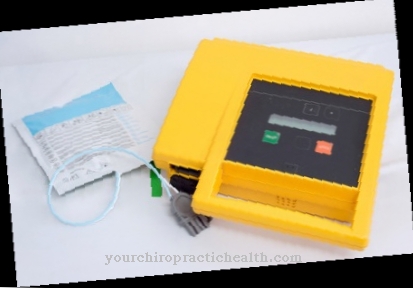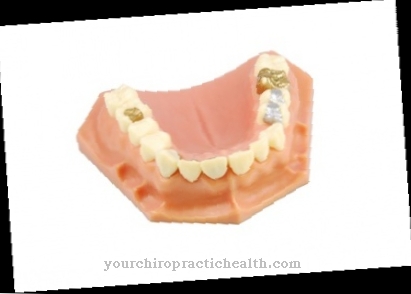At a die (Dentistry) is a technical aid that is used in dental treatments. Dentists use the matrix when they place a tooth filling and use a plastic material to fill the cavity in the tooth. Basically, a matrix is used when the tooth has an opening to the outside. At the same time, a female part is the counterpart to the male part.
What is a die?
The term matrix comes from Latin and is derived from the word for 'mother'. In dentistry, the term matrix has two meanings. On the one hand, the matrix is an aid that doctors use when placing fillings. A plastic filling substance is used here.
On the other hand, in dentistry, a matrix is the counterpart to the patrix. The matrix and patrix combine to form the so-called attachment and thus form a coherent unit.
Shapes, types & types
The classic die is made up of a metal band. In some cases the die is also made of plastic. The dentist places the band around the tooth when placing a filling. For example, composite or amalgam fillings come into question, which are basically a plastic substance for filling an outwardly open cavity in the tooth. The doctor puts the filling material into the open tooth while the substance is still soft and malleable. In this way, the dentist repairs various defects in the tooth, such as holes.
The main function of the matrix is to hold the soft filling material in the desired cavity, because a hole in the tooth is not completely surrounded by tooth enamel in all cases. More often the cavity is more open on one or more sides, so that the plastic filling material threatens to flow out. Since the band of the matrix surrounds the corresponding tooth for the duration of the treatment, the dentist prevents the filling substance from escaping.
Thus, the die is primarily a form aid that holds the filling compound at the point of application. If the dentist places an amalgam filling, in most cases he will use a so-called ring band matrix. In contrast, the plastic matrix is mainly used when the doctor places a filling with plastic material in the area of the front teeth. The dentist inserts the matrix between the defective and the neighboring tooth. In this way, the matrix prevents the neighboring tooth from sticking to the filling material. Since plastic fillings usually harden under blue light of a certain wavelength, the doctor often uses transparent matrices for these cases.
In addition, the term matrix in dentistry relates to attachment technology, also called dental attachments by dentists. The attachment is created by the interaction of the matrix and patrix. In this case, the male part forms the positive part of a removable prosthesis called an attachment. The male part fits perfectly into the female part, creating a certain hold.
Structure & functionality
The basic element of a die is a band made of either metal or plastic. The dentist places this band around the tooth during therapy to prevent the soft filling material from escaping. The matrix is basically used when it is necessary to fill cavities that are exposed to the outside in the tooth.
A ring band matrix, for example, is made up of thin steel sheets that adapt perfectly to the shape of the tooth and thus largely prevent the filling substance from escaping. In dentistry, matrices are used in particular to place fillings between teeth.
The other meaning of the term 'matrix' refers to the attachment construction, which fulfills a different function and does not serve to place dental fillings. The matrix as the counterpart to the patrix is part of the attachment prosthesis. This attachment consists of a fixed and a movable, removable section. The female and male molds act as connecting elements between the two components.
The dentist either produces the attachment individually for the patient or uses prefabricated prostheses in standard sizes. The T-attachment is used particularly often, with the male part merging into an elongated slot in the female part. In principle, both activation and deactivation of the die are possible. In the course of this, the dentist presses the matrix together or expands it in order to influence the hold of the prosthesis.
You can find your medication here
➔ Toothache medicationMedical & health benefits
The matrix as a supporting element when placing dental fillings prevents plastic filling substance from penetrating into or touching undesired areas. In this way, the matrix prevents, for example, filling material from sticking to neighboring but healthy teeth. In addition, the matrix also protects the gums from excessive contact with the soft filling substance. Overall, the matrix enables the filling material to be applied precisely to the defective area and makes it easier for the dentist to quickly and cleanly place the tooth filling.
The female part as an attachment element, together with the male part, ensures that the dental prosthesis is held in place by interlocking the two parts. By adjusting the matrix by the dentist, the prosthesis is either looser or tighter.



























